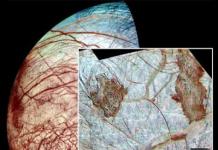Astronomers have concluded that beneath the thick layer of ice covering Jupiter's moon Europa lies an ocean of water extremely rich in oxygen. If there was life in this ocean, then this volume of dissolved oxygen would be enough to support millions of tons of fish. However, so far there is no talk of the existence of any complex forms of life on Europa.
Scientists say that recent ocean studies on Europa indicate that this huge basin has all the conditions for the emergence of life, at least at the microbacterial level.
Europa is one of the most interesting satellites of Jupiter. In size it is comparable to the Moon, but Europa is covered with a layer of ocean, the depth of which is about 100-160 kilometers. True, on the surface this ocean is frozen; the thickness of the ice, according to modern estimates, is about 3-4 kilometers. Guided by earthly experience, it can be argued that where there is water, there must be life. Since there is water on Europe, moreover, there is a lot of it there, then there are also many chances for life to live there.
The chances of life emerging on Europa are even greater if other factors are taken into account. Recent modeling by NASA suggests that Europa could theoretically support the most common marine life forms found on Earth.
The ice on the surface of the satellite, like all the water on it, consists mainly of hydrogen and oxygen. Given that Europa is constantly bombarded by radiation from Jupiter and the Sun, the ice forms so-called free oxygen and other oxidants such as hydrogen peroxide. It is obvious that there are active oxidants under the surface of Europa. At one time, it was active oxygen that led to the emergence of multicellular life on Earth.

In the past, the Galileo spacecraft discovered an ionosphere on Europa, indicating the existence of an atmosphere around the satellite. Subsequently, with the help of the Hubble orbital telescope, traces of an extremely weak atmosphere, the pressure of which does not exceed 1 micropascal, were actually noticed near Europa. The atmosphere consists of oxygen, formed as a result of the decomposition of ice into hydrogen and oxygen under the influence of solar radiation (light hydrogen evaporates into space at such low gravity).
The only thing that makes it difficult for complex life forms to arise is the isolation of the ocean. That is, quite a lot of complex organic compounds float in the Solar System as part of asteroids and comets, but when they hit the surface of Europa, it is almost impossible for them to penetrate through a thick layer of ice. Thus, life on Europa must have originally originated in the depths of the ocean.
However, recent studies and models in Europe indicate that organic compounds do not necessarily need to penetrate to a depth of 3-4 kilometers. Already at a depth of about 10 meters, the oxygen concentration increases significantly, and the density of the ice decreases. Thus, theoretically, life on Europa could already be at a depth of 10 meters.
Richard Greenberg of the Planetary Laboratory at Arizona State University says that searching for life on Europa doesn't necessarily require exploring the subglacial ocean.
In addition, the scientist believes that the water temperature on Europa may be significantly higher than most researchers assume. The fact is that Europe is in the strong gravitational field of Jupiter, which attracts Europe 1000 times stronger than the Earth attracts the Moon. Obviously, under such gravity, the solid surface of Europe on which the ocean is located should be very active geologically, and if so, then there should be active volcanoes, the eruptions of which raise the temperature of the water.

Greenberg says recent computer models show Europa's surface actually changes every 50 million years. In addition, at least 50% of Europa's floor is mountain ranges formed under the influence of Jupiter's gravity. It is gravity that is responsible for the fact that a significant part of the oxygen on Europa is located in the upper layers of the ocean.
“Approximately 40% of the surface of Europe is chaotic areas. We can say with a certain degree of confidence that there are many faults at the bottom that store heavy chemical elements,” says the scientist.
Taking into account the current dynamic processes on Europa, scientists have calculated that to achieve the same level of oxygen saturation as on Earth, Europa's ocean only needs 12 million years. “Over this period of time, enough oxide compounds are formed here to support the largest marine life that exists on our planet,” he notes.
Europa, which is the smallest of the four satellites of Jupiter discovered by the Italian scientist and astronomer Galileo Galilei in 1610, is one of the largest satellites of the planets in the solar system and is slightly smaller in size than such a “giant” as the Moon.
Galileo, having discovered Europa and three more satellites of Jupiter, assigned them serial numbers and called this group of celestial bodies the “Medici planets.”
The smallest of the “Galilean Moons” was designated the second satellite of the planet Jupiter. The currently commonly used name “Europe” was proposed in 1614 by Simon Marius, who, according to available information, also laid claim to the discovery of this satellite, but practically until the middle of the 20th century this name was not used. The smallest satellite of Jupiter is named after the beloved of Zeus (Jupiter), who is a character in ancient Greek myths.
physical characteristics

One of the interesting features that Jupiter's moon Europa has is that it always faces its planet with the same side. In its physical and geological characteristics, it is more similar to the planets included in the terrestrial group, which are largely composed of rocks, than to other “ice-covered satellites”. The temperature at the surface of Europa, covered with an estimated 100 km layer of water and bound by an ice shell about 10-30 km thick, is only 150-190°C below zero. Europa is a small metallic core covered in rocks, which in turn are shrouded in vast volumes of water and liquid ice in a subsurface ocean.
Research

As a result of a few studies of this satellite, scientists were able to detect the presence of an ionosphere, and based on this, assume the existence of an atmosphere. This hypothesis was later confirmed by the Hubble Space Telescope, which discovered traces of a subtle atmosphere. The formation of the atmosphere of this cosmic body is explained by the decomposition of ice into particles of oxygen and hydrogen, which is facilitated by solar radiation, while light particles of hydrogen, due to the insignificant magnitude of the gravitational force, evaporate into space.
Surface characteristics

The surface of Europa is dotted with many intersecting lines and faults, but by cosmic standards it is considered relatively flat, with only a small number of formations resembling hills, several hundred meters high, chaotically distributed across its surface.

The number of surface craters is very small. At the moment, only three craters with a coverage area of more than 5 km have been discovered, which indicates the relative youth of the surface, whose age presumably does not exceed 30 million years and has high geological activity. Europa's surface is highly radioactive because its orbit coincides with the powerful radiation belt of the planet Jupiter.
Jupiter's satellite Europa. NASA
The second of the Galilean satellites, Europe, somewhat smaller in size than our Moon. Galileo named the satellite he discovered in honor of Princess Europa, who was kidnapped by Zeus the bull.
Europa's diameter is 3130 km, and the average raft The density of the substance is about 3 g/cm3. It is covered with water ice. There appears to be an ocean of water beneath the 100-kilometer-thick ice crust that covers the silicate core. The surface is dotted with a network of light and dark lines: apparently, these are cracks in the ice crust that arose as a result tectonic processes Their thickness sometimes exceeds a hundred kilometers, and their length reaches several thousand kilometers. There are practically no craters on the surface of Europa, which indicates that the surface of the satellite is young - hundreds of thousands or millions of years. There are no hills more than 100 m high. The width of the faults ranges from several kilometers the ditch is up to hundreds of kilometers long, andrange reaches thousands of kilometers. EstimatedThe thickness of the crust ranges from several kilometers to tens of kilometers.In the depths of Europe there is also tidal interaction energy which maintains a liquid state mantle - subglacial ocean, possibly but even warm. It is not surprising, therefore, that there is an assumption about the possibility of existence in this ocean of pro the simplest forms of life. Judging by the average density of the satellite, there must be silicate rocks under the ocean. Because the craters on Europa, which has quite smooth surface, very few, the age of the details of this orange-brown surface is estimated to be hundreds of thousands and millions of years. In the photographs of highpermissions received by Galileo, viewWe have separate fields of incorrect form we have elongated parallel ridges and valleys reminiscent of the highway Seed roads. Dark spots stand out in a number of places: most likely these are deposits of substance carried out from under the ice layer.
|
|
|
|
Surface of Jupiter's moon Europa NASA |
Internal structure of Jupiter's moon Europa |
According to the American scientist Richard Greenberg, conditions for life on Europa should be sought not in the deep subglacial ocean, but in numerous chinah. Due to the tidal effect, cracks periodically narrow and widen up to a width of 1 m. When the crack narrows, the ocean water goes down, and whenit begins to expand, water rises along it almost to the very surface.They penetrate through the ice plug that prevents water from reaching the surface. the sun's rays, carrying the energy necessary for living organisms.
On December 7, 1995, the Galileo space station entered the orbit of Jupiter, which made it possible to begin unique studies of its four moons: Io, Ganymede, Europa and Callisto. Magnetometric measurements showed significant disturbances in Jupiter's magnetic field near Europa and Callisto. Apparently, the detected variations in the magnetic field of the satellites are explained by the presence of an “underground” ocean with a salinity close to the salinity of the Earth’s oceans (37.5 ‰). The possible existence of an underground water ocean on Europa has been debated for more than two decades. Accretionary, radiogenic and tidal heat sources on the satellite are powerful enough to cause dehydration of the deep layers and the formation of a surface layer of water more than 100 km thick. Gravity measurements carried out by the equipment of the Galileo station confirmed the differentiation of Europa's body: a solid core and a water-ice cover about 100 km thick, which well reflects the sun's rays. Perhaps this ocean is even warm: there are suggestions about the existence of primitive life forms in it. International expeditions are being planned to explore the supposed oceans of Europe.
MOSCOW, September 26 - RIA Novosti. The orbiting Hubble Observatory has received unique photographs of geysers appearing and erupting on the surface of Europa, a satellite of Jupiter, scientists reported at a press conference at NASA headquarters.
"We have found new evidence that Europa contains geysers that eject into space. Our new and previous observational data show that beneath the surface of this moon of Jupiter there is a subglacial salt ocean, hidden from us under several kilometers of ice. The discovery of geysers suggests “We can study its contents by observing their emissions and try to understand whether they contain life,” said William Sparks from the Space Telescope Institute in Baltimore (USA).
As NASA later noted, answering questions from a RIA Novosti correspondent, the Juno probe, despite having powerful instruments and capabilities for observing these geysers, will not conduct them, since NASA fears that this automatic station may contaminate the emissions of geysers and create the false impression that they may contain organic molecules, and potentially microbes, that actually entered Jupiter's orbit from Earth.
World of Ice and Fire
On Europa, one of the four largest satellites of Jupiter discovered by Galileo, there is an ocean of liquid water under a multi-kilometer layer of ice. Scientists consider Europa's ocean one of the likely refuges of extraterrestrial life. In recent years, astronomers have discovered that this ocean exchanges gases and minerals with ice on the surface, and have also confirmed the presence of substances necessary for the existence of microbes.
As Sparks said, the first possible traces of the existence of geysers on Europa were found back in 2012, when American astronomer Lorenz Roth discovered traces of unusual “bright spots” in the area of the south pole in ultraviolet photographs of Europa obtained using Hubble. planets. Ros and his team believed the spots were geyser eruptions rising 200 kilometers above Europa's surface.
These observations attracted the attention of NASA scientists, and they conducted several additional observation sessions of Europa in 2014, observing it at the moment when the planet passed across the disk of Jupiter, against which the geyser emissions should have been especially noticeable. Europa is one of the closest moons to Jupiter, causing it to pass across the disk every 3.5 days, making observations easier.

In total, NASA studied ten similar passages of Europa. As Sparks noted, Hubble was able to see similar traces in the ultraviolet and optical flashes, potentially associated with geyser eruptions, in three similar images. As with Ros's observations, most of the flares were concentrated at the planet's south pole, but in one photograph, scientists noticed possible evidence of geysers in the vicinity of Europa's equator.
Scientists are not yet ready to say that they have actually found geysers, since, according to Sparks, the observation data is within the resolution and capabilities of Hubble. The launch of its successor, the James Webb Telescope, will help put an end to this issue.
© From Schmidt et al., “Active formation of chaos terrain over shallow subsurface water on Europa”, Nature, 2011.This is how the artist imagined the formation of a “polynya” in the ice of Europe

© From Schmidt et al., “Active formation of chaos terrain over shallow subsurface water on Europa”, Nature, 2011.
Is there life on Europa?
If geysers on Europa really exist, then their existence gives us a chance to study the contents of the ocean of this satellite of Jupiter without diving into it, including assessing its suitability for life. In addition to the emissions themselves, the surface of Europa will also be of interest to scientists, since it will be covered with geyser eruptions and matter from its subglacial ocean.
Why do geysers on Europa erupt relatively rarely? According to Britney Schmidt from the University of Texas at Austin (USA), one of the participants in the discovery, the reason for this lies in the fact that the tidal forces generated by Jupiter and heating the bowels of Europa are not strong enough to constantly split it apart ice sheet
Subglacial volcanoes scratched the ice sheet of Jupiter's moon - scientistsThe depressions, crevices and protrusions that cover the icy surface of Europa, a moon of Jupiter, turned out to be “scars” from the activity of subglacial volcanoes and other sources of geothermal energy, American astronomers report in an article published in the journal Nature.Geysers, as Schmidt suggested back in 2011, arise in peculiar “polynyas”, which arise as a result of the heating of the ice of Europe under the influence of tidal forces and the eruption of subglacial volcanoes. Such “polynyas” freeze very quickly, within a few tens of thousands or hundreds of thousands of years, and this may explain why the geysers on Europa erupt extremely irregularly.
According to Kurt Niebuhr, director of the upcoming Europa Clipper mission, the potential discovery of geysers is increasing interest in this planet, but scientists need more data in order to understand how dangerous these geysers will be for the probe and how they can be studied. . Therefore, he suggests waiting for the launch of the James Webb in order to understand whether it is worth installing tools for collecting water and ice on the Europa Clipper or not.
Europa, a Galilean satellite of Jupiter, is located immediately after Io. However, it is the second among the Galilean satellites, and among all the known satellites of Jupiter it is number six in terms of distance from the planet. Like the other Galilean satellites, Europa is a unique world, almost unlike all the others. Moreover, it is possible that there is life there!
- This satellite is only slightly smaller than the Moon - its diameter is about 3000 km, compared to the lunar 3400 km. Among the Galilean satellites, Europa is the smallest - Io, and Callisto is much larger. In terms of size, Europa ranks 6th among all the satellites of the Solar System, however, if you lump together all the other, smaller satellites, then Europa will have a large mass.
- Europa consists of silicate rocks, like , and has a metallic core inside. When rotating in orbit, this satellite of Jupiter, like other large satellites, always turns one side towards the planet.
- The top layer of Europa, as scientists assume, and there is a lot of evidence for this, consists of water. That is, there is a huge ocean of salt water, the composition of which is quite similar to the composition of terrestrial sea water. And the surface of this ocean is an ice crust 10-30 km thick - we can observe it.
- There is evidence that Europa's interior and crust are rotating at different speeds, with the crust being slightly faster. This slippage occurs because there is a thick layer of water under the crust, and it is not in any way adhered to the silicate rocks at the bottom of the subglacial ocean.
- Europa has absolutely no craters, mountains, or other landscape details that we would expect to see here. The surface is almost flat, and Europa looks more like a bare, smooth ball. The only thing there is cracks and breaks in the ice surface.
Surface of Europa
If we were on the surface of this satellite of Jupiter, then our eye would have almost nothing to cling to. We would see only a continuous ice surface, with very rare hills several hundred meters high, and cracks crossing it in different directions. There are only about 30 small craters on the entire surface, and there are areas with debris and ice ridges. But there are also huge, perfectly flat areas of recently spread and frozen water.

Detailed images of Europa at a short distance have not yet been obtained, although it is planned to fly around this satellite with the JUICE apparatus at an altitude of up to 500 km, but this will happen only in 2030. Until now, the best images were taken by the Galileo apparatus in 1997, but their resolution is not very good.
Europa has a high albedo - reflectivity, which indicates the comparative youth of the ice. This is not surprising - Jupiter has a powerful tidal effect, which causes the surface to crack and a huge amount of water to pour onto it. Europe is a geologically active body, but it is not possible to notice any changes on it even after decades of observation.
However, being on the surface, we will experience incredible cold - about 150-190 degrees below zero. In addition, the satellite is located in the radiation belt of Jupiter, and a radiation dose a million times higher than that on Earth would simply kill us.
Subsurface ocean and life on Europa
Although Europa is much smaller than the Earth, and even slightly smaller than the Moon, the ocean under its icy shell is truly huge - its water reserves can be twice as large as in all the earth's oceans! The depth of this subsurface ocean can reach 100 km.

Water ice on the surface is exposed to cosmic radiation and solar ultraviolet radiation. Because of this, water breaks down into hydrogen and oxygen. Hydrogen, as a lighter gas, escapes into space, and oxygen forms a thin and very rarefied atmosphere. Moreover, this oxygen can penetrate into the water, thanks to cracks and mixing of the ice, and gradually saturate it. Although this process is slow, over millions of years, and thanks to the large surface, the water in Europa's ocean could well be saturated with oxygen to the level of its concentration in terrestrial sea water. Calculations also confirm this.
Moreover, research also suggests that the concentration of salts in the water is also most likely close to terrestrial seawater. Its temperature is such that the water does not freeze, that is, it is quite comfortable for living organisms even by earthly standards.
As a result, we have a curious and paradoxical situation - the opportunity to find life, albeit microscopic, where no one expected to find it. After all, the conditions in the ocean of Europe should be practically similar to those that exist in the deep waters of the earth’s oceans, and there is life there too. For example, terrestrial extremophiles feel quite good in such conditions.
Europa may have its own ecosystem, and when trying to study it, there is a risk of disturbing it by introducing terrestrial microorganisms there. Therefore, when the Galileo apparatus completed its mission, it was sent into the atmosphere of Jupiter where it burned up safely, leaving nothing behind that could accidentally end up on Europa or other satellites.
Future studies of Jupiter's moon Europa
Due to the possibility of life on Europa, this satellite is far from the last place in the plans of scientists. On the contrary, its study in this regard is on the list of priority tasks. However, everything is not so simple.
There are not only huge distances on the way of researchers - space probes have long learned to overcome them. But the real obstacle is Europa's icy crust, which is 10 km or more thick. Various options for overcoming it are being developed, and there are some that are quite feasible.
The next flight to Jupiter will be made by the European Jupiter Icy Moon Explorer, which is planned for 2020. He will visit Europa, Ganymede and Callisto. Perhaps it will provide a lot of valuable information that will facilitate penetration into the Europa ocean in future expeditions.
Observation of Jupiter's moon Europa
Of course, the telescopes available to astronomy enthusiasts will not be able to examine any details on Jupiter’s satellites. However, you can observe, for example, the passage of satellites and their shadows across the disk of the planet - this is a rather curious phenomenon.
You can see all four Galilean satellites with 8-10x binoculars. In a telescope, even a very small one, they can be seen very clearly, of course, in the form of stars. More powerful telescopes can distinguish their hue; for example, Io has a yellowish color due to the abundance of sulfur.
You can learn more about this unique moon of Jupiter from the National Geographic film “Journey to Europa.”






















